From the University of
Wisconsin-Madison
by Susan Mahr
Garlic
Chives
Allium
tuberosum
Allium
tuberosum is a late-season bloomer from the onion family. Native to
southeastern Asia, it is known by several common names including garlic
chives, Chinese chives or Chinese leek. It is sometimes confused with a
very similar species, A. ramosum or fragrant-flowered garlic, but that
plant blooms earlier in the year and has a slightly different leaf
structure. Although A. tuberosum is typically used as an ornamental in
North America, it is edible and has been used in Chinese herbal
medicine for a variety of ailments.
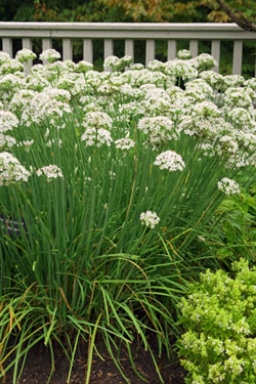
Garlic chives bloom in the fall
This herbaceous
perennial, hardy in zones 3-9, forms slowly expanding clumps of
gray-green foliage 10-20" tall. Each elongate, poorly developed bulb is
attached individually to a stout rhizome similar to that of an iris,
and produces 4-9 leaves. The narrow, flattened, strap- or grass-like
leaves arch downward at the tips, forming a fountain of green that
remains tidy and attractive throughout the growing season. When bruised
or crushed the leaves (and other plant parts) have a strong onion or
garlic scent. In warmer climates the plants are evergreen, but in
colder climates they die back to the ground over the winter. Just like
chives, cutting the leaves back encourages new growth. Leaves can be
harvested to eat anytime they are green.
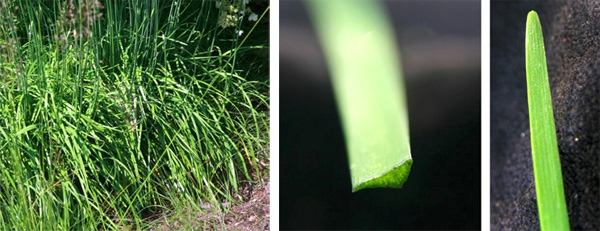
The
grass-like foliage of garlic chives (L). Each narrow leaf is flattened
to be roughly triangular in cross-section (C), with a rounded tip (R).
In
late summer to early fall, flowers open on sturdy, two to three
foot-tall stalks well above the foliage. Each 2-3" wide loose umbel
contains many small, white, star-shaped flowers with brown-striped
tepals. The flowers are attractive to butterflies, bees and other
pollinators, with a sweet scent. They are good for cutting and the seed
heads for dried arrangements.
Flowers of Allium tuberosum
emerge from papery buds (L) to open in loose umbels of star-shaped,
white flowers (R).

Flowers of Allium tuberosum
emerge from papery buds (L) to open in loose umbels of star-shaped,
white flowers (R).
Eventually the flowers are
followed by dark, papery capsules filled with hard, triangular-shaped
black seeds. Because it self seeds very readily and produces seed
prolifically (like many ornamental onions), it is best to cut off the
flower stalks as soon as they have finished blooming to prevent rampant
spread.
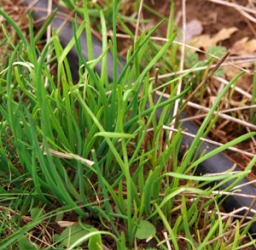
Garlic
chives coming up in spring.
Even though it can
spread aggressively by seed, the seedlings are relatively easy to
remove when young (although they can be quite numerous, so weeding may
take a lot of time). This plant can be invasive under some conditions,
so should be planted with care.
Grow garlic chives
in full sun in well-drained soil. It can easily be started from seed,
or from divisions. Once established, A. tuberosum is very heat, cold
and drought tolerant. Clumps should be lifted and divided about every 3
years to maintain vigor and blooming.
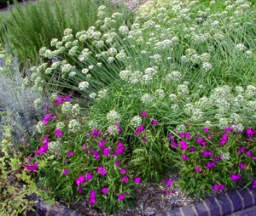
Garlic chives grow best in full sun.
Garlic
chives combine well with many perennials and annuals. The grayish
leaves soften bright oranges and set off pink or rose-colored flowers.
They are a nice contrast to purple foliage, such as dark-leaved sedums
or heucheras. Plants can be used as low-maintenance edging or in
containers to provide vertical interest when in flower. Potted plants
can be brought inside over the winter for a supply of leaves for
cooking.
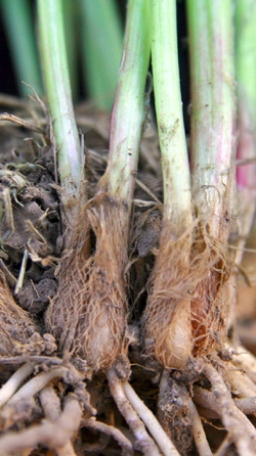
The
poorly developed bulbs.
The flavor of the leaves of
A. tuberosum is subtle, like very mild garlic, while the narrow bulbs
are strong and sharp when eaten raw. The leaves are used similarly to
the way chives or green onions are used, and are especially useful to
add mild garlic flavor in uncooked dishes where raw garlic would be too
overpowering. They can be added to salads, egg dishes, soups, or stews,
but should be added at the end of cooking in hot dishes as too much
heat destroys the mild flavor. It is used in stir fries and other
dishes in several oriental cuisines, especially Korean. The flowers are
also edible, so can be used as a garnish or added to salads.
Additional
Information
Allium tuberosum
- on the Missouri Botanic Garden’s Kemper Center for Home Gardening
website at www.mobot.org/gardeninghelp/plantfi nder/plant.asp?code=U770
Allium tuberosum - on Floridata at www.floridata.com/ref/a/alli_tub.cfm
|
© by the Board of Regents of the University of Wisconsin System
doing business as the division of Cooperative Extension of the University of Wisconsin-Extension
|





